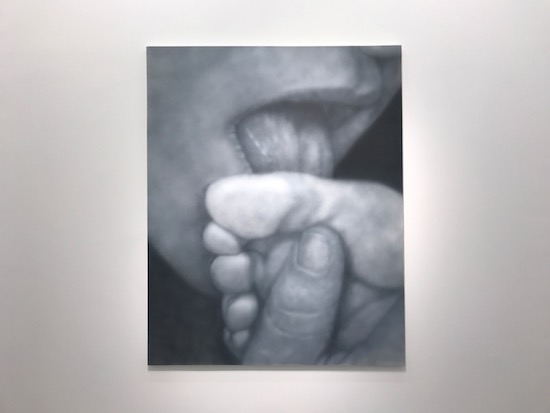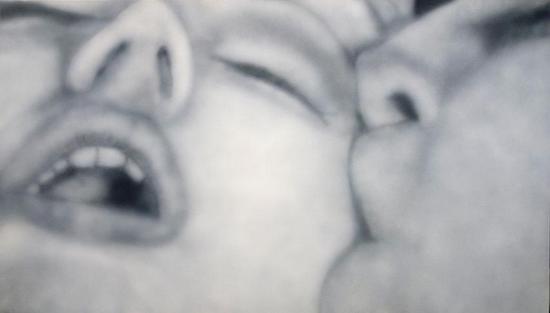Innovations in conceptual art often predict progressions in cultural attitudes. When female artists like Marilyn Minter and Judith Bernstein started incorporating raw sexual imagery into their work in the 1970s, they often found themselves shunned – not just by the patriarchal network of collectors and curators, but also by feminists of the time who saw the work as too exploitative of the female form. Minter herself has noted that the support of gay men and women and other artists is the only reason her career has lasted as long as it has. But feminism has been widening its scope ever since, and is now at least partly defined by a sex positive outlook that argues true equality is being able to celebrate female sexuality and pleasure – and if a woman chooses, allow herself to be objectified. Young artists like photographer Sandy Kim, selfie artist Leah Schrager, and photographer Talia Chetrit often invite the male gaze, taking ownership over their bodies and sexuality by giving the viewer a lens into an aspect of their owns sexualities.
Cultural attitudes toward sex have moved forward – more or less – and artists like Minter and Bernstein are at peak cultural influence some four decades in their careers: Minter’s Pretty/Dirty career retrospective just enjoyed a six month stay at The Brooklyn Museum and Bernstein’s 2016 exhibition at Mary Boone gallery, and its accompanying catalog Dick of Death, was among the finest received bodies of work in her career.
Artist Betty Tompkins’ monochromatic photo-realist paintings are probably the most sexually explicit out of all three of them and she too has seen a boost in her public profile. Like Minter and Bernstein, Tompkins had been creating explicit sexual imagery since the late sixties but didn’t fully penetrate the art world’s critical elite until the early 2000s, when cultural attitudes toward women and sex had moved forward. Her current exhibition at P POW gallery, Virgins, finds the artist with particular conviction in her sexuality, validated by an art world that left her out of the conversation for far too long.
Tompkins’ paintings invite the male gaze and reveal the gaze’s ultimate impotence, reframing the female body and feminine sexuality as a site of power. The works included in VIRGINS, including the large-scale FUCK PAINTINGS as well as the PUSSY PAINTINGSare explicit in content. But Tompkins doesn’t rely on brash confrontation to get her ideas across. The images exude elegance and have a kind of decorative quality to them. This is sex. This is a female body. This is beautiful. This is power.
The FUCK PAINTINGS, elegantly composed as they are, are less concerned with aestheticising sexuality in the ways in which Minter does with her painted photographs. Instead, Tompkins applies a nuanced portrayal of sexuality in her work to place both male and female pleasure on equal plateaux. The work isn’t particularly confrontational and as such reveals a viewer’s ingrained sexual hangups. Matter of factly, a penis enters a vagina. This is sex, to be enjoyed by women as much as it is to be enjoyed by men.
Tompkins sources most of her imagery from pornography (she initially got the idea by browsing her first husband’s porno collection in 1969), and if anything her art work seems de-aestheticise the pornographic images more than it ‘elevates pornography’ as is the common critical line found in this kind of art-porn balance (Robert Mapplethorpe’s photographs could be argued as a kind of elevated porn, for example). Tompkins’s large-scale paintings remove the capitalist machinations of the male gaze found in her pornographic source material that seeks to objectify the female body and exploit her sexuality.
One of the least pointedly sexual paintings of the show that is perhaps most indicative of Tompkins’ concepts is one in which a man kisses a woman’s cheek while the woman’s eyes roll into the back of her head and her mouth gapes open. The woman’s pleasure is the one that needs attending to and the man attends to it.
Until recently, with female pornographers like Erika Lust bringing female consent into adult entertainment, the close-up of female pleasure rarely existed in pornographic content. Even the depictions of penises in Tompkins’ FUCK PAINTINGS purposefully avoid the typical markings of phallic imagery. The penises are not portrayed as something to admire, and definitely not something to fear, they are merely one half of the sexual act. No more important than the vagina in the act of sexual pleasure.
Tompkins’ work has an underhanded way of revealing the hypocrisy in demonising an act (sex, in this case) that we all biologically crave as well as censoring the body parts inherent to that act. Censorship itself is an act of demonisation, because to censor is to imply that what is censored is wrong.
When Tompkins was in art school, her professor asked her what she was going to do post-graduation. When she told him she’d be a New York artist, he replied, “You’re going to spend a lot of time on your back.” But instead of allowing sex to instil fear within her, she rejected the popular feminist ‘un-pleasure principle’ of the seventies. Instead, she took sex back and celebrated it.

Female artists are more than ever gaining success on the crowded art market, and willingness to put sexuality on display has increasingly become a source of admiration amongst critical circles. Young artists like India Menuez and Alexandra Marzella are rejecting the tenets of anti-porn feminism and have become sources of much media fascination as a result.
Tompkins laid the ground work for this kind of female sexual representation in art work and suffered for it. After all, it wasn’t until 2003 when the FUCK PAINTINGS were unearthed by New York magazine art critic Jerry Saltz after Tompkins sent him some slides when she heard he was curating a show about sex. Saltz got them in the hands of dealer Mitchell Algus and finally Tompkins was able to penetrate the cultural paradigm. But now with female reproductive rights under the threat of full-scale assault, particularly due to Trump’s nomination of anti-abortion hard liner Neil Gorsuch to the Supreme Court, it’s poignant that Tompkins revisits the FUCK PAINTINGS and the PUSSY PAINTINGS.
An attack on a woman’s right to choose is an attack on a woman’s right to experience pleasure. It is an attack on a woman’s right to take ownership over her own sexual desire. While Tompkins’ paintings have been accepted by an increasingly progressive art world, the election of Trump reminded us all that a lot of people outside of the art world don’t have the same values as those in it. Tompkins still has feathers to ruffle. Someone should invite Sean Hannity to her next exhibition, then we can truly see who the real snowflake is.
Betty Tompkins, Virgins, is at P•P•O•W, New York, until 13 May 2017


